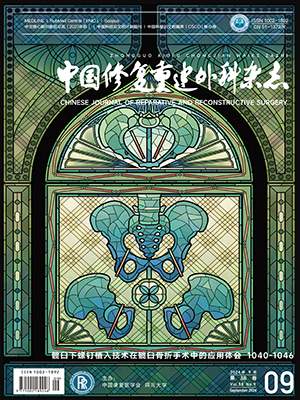Objective To investigate the feasibil ity of core fat transfer by comparing with traditional Coleman technique. Methods The fat was obtained from 11 patients scheduled for fat transfer by 2 ways: Coleman’s method and core fat graft. The latter was harvested by a modified 1 mL syringe. Then 48 nude mice at the age of 3-4 weeks, male or female, weighing 8.6-12.2 g, were divided into 2 groups randomly (n=24). The dorsal subcutaneous space was recipient site. In the experimental group, 0.5 mL core fat was transplanted into dorsal subcutaneous space; in the control group, 0.5 mL fat
obtained by Coleman’s method was transplanted into the same site. The appearance of the back was observed after operation; fat specimens were procured at 1, 2, 4, and 8 weeks after operation for the gross, histological, and immunohistochemical observations; and the residual weight of free fat-graft was calculated by the difference between pre- and post-operative mouse weights. The glucose transportation quantities and cell viabil ity were measured immediately after obtaining fat. Facial augmentation procedure was performed with core fat graft in 11 patients with local depressed deformity between May 2010 and October 2011. Results The uplift of the back was maintained in the experimental group, but the back of mice became flat in the control group at 2 weeks postoperatively. There was no significant difference in the weight of fat-graft between 2 groups (P gt; 0.05). The residual weight of fat-graft in the experimental group was significantly higher than that in the control group at the other time (P lt; 0.05, except for 2nd week postoperatively). The histological observation showed good cell morphology and well-distributed vessels in the experimental group, but obvious destruction of the cells and most vessels at the edge of fatgraft in the control group. The normal fat cells in the experimental group were significantly more than those in the control group after operation (P lt; 0.05), except for 2nd week). The capillaries in the experimental group were fewer than those in the control group, showing significant differences at 1 week and 2 weeks (P lt; 0.05) and no significant difference at 4 and 8 weeks (P gt; 0.05). The glucose transportation quantities in the experimental group [(1.462 ± 0.080) mmol/L] was significantly higher than that in the control group [(1.153 ± 0.199) mmol/L] (t=3.317, P=0.021). The higher cell viabil ity was also proved in the experimental group. Eleven patients were followed up 2-9 months, and no obvious atrophy or collapses was observed at reci pient site. Conclusion Compared with Coleman technique, core fat graft can keep the structure and viabil ity of harvested fat tissue by avoiding certain damages of fat cell. Therefore, the earl ier anastomoses between the host and core graft fat can reduce tissue loss and improve the fat survival. So it is recommended for enblock fat graft.
Citation: QIN Wangchi,XU Yangbin,LIU Xiangxia,XU Shuqia.. EXPERIMENTAL AND PRIMARY CLINICAL RESEARCH OF CORE FAT GRAFT. Chinese Journal of Reparative and Reconstructive Surgery, 2012, 26(5): 576-582. doi: Copy




